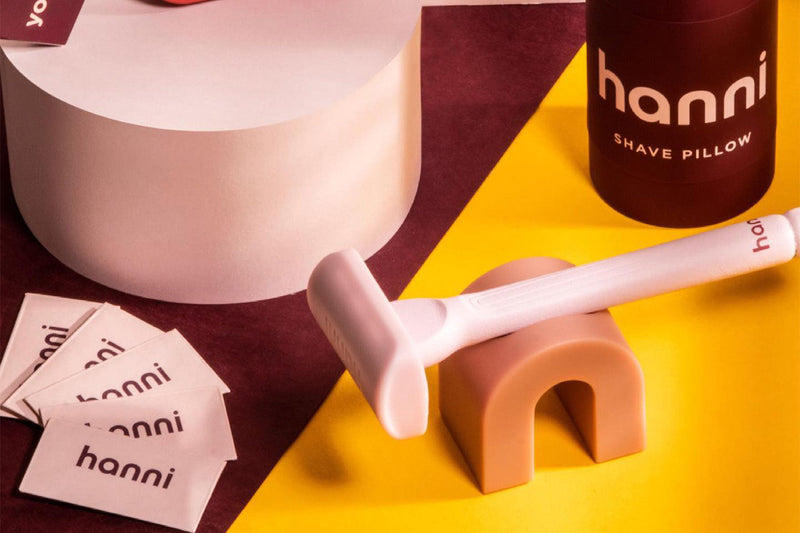When life gets busy, self-care is often the first thing to go out the window. We try to convince ourselves that we’re “too busy” or our self-care sundays didn’t really do anything anyway. But deep down, we know that isn’t true. In fact, it’s actually the exact opposite — self-care is super important, especially in those busy moments.
When you’re dealing with a lot of stress, you need to take care of your body. Whether you’re overwhelmed by life at school, work, or home, the best way to decompress at night and get ready for the morning is by indulging in a little self-care. Here at Hanni, one of our favorite types of self-care is skin care.
What is dermaplaning?
Dermaplaning is a minimally invasive cosmetic procedure that scrapes away the debris clogging the top layer of your skin. Approved by certified dermatologists as a monthly addition to your skincare routine, dermaplaning can minimize acne scars, brighten dull skin, and encourage rejuvenation in even the toughest of problem areas.
Dermaplaning origins
Before dermaplaning was a common skincare hack, it was a medical procedure. First published in dermatology articles in the 1970s, dermaplaning was designed to treat acne vulgaris, more commonly known as acne. Though medical professionals quickly found the treatment too harsh for those with active breakouts, dermatologists and plastic surgeons repurposed the procedure for a number of other skin problems.
In its earlier years, dermaplaning was an alternative to chemical exfoliation. Rather than applying toxic products to clients’ skin, aestheticians sought safer methods for achieving smooth skin. In removing the skin’s top layer of dead skin via physical methods rather than chemical ones, both professionals and everyday people achieved smoother skin in a more safe way than ever.
Though dermaplaning is still used for exfoliation purposes today, our understanding of the treatment has grown – as have our techniques.
Skin and beauty benefits
Though dermaplaning is not a viable treatment method for active acne, it is extremely effective in treating acne scars.
Dermaplaning can help reduce the appearance of acne scars by removing the external skin affected by hyperpigmentation. While removing other dead skin cells, dermaplaning scrapes away hyperpigmented skin cells, including cells darkened by past acne. Especially when used in tandem with other skincare products known for brightening skin, people who undergo regular dermaplaning treatments may find their acne scars fade faster than people who do not.
The benefits of dermaplaning don’t stop there. In addition to brightening the skin (which includes reducing the appearance of regular dark spots, by the way), this treatment also promotes smoother skin.
Dermaplaning rids your skin of its peach fuzz. Also known as vellus hairs, these fine hair follicles cover your skin, increasing its natural texturization. For some, this texture can be irritating. Like hair removal for your armpits or legs, many people prefer to achieve smoother skin by shaving the vellus hairs from their face.
How to dermaplane
If you’re struggling with acne scars, are annoyed by that pesky peach fuzz, or simply want to give this skincare treatment a try, it’s time to start exploring different dermaplaning options. Generally speaking, there are two routes you can try
Route 1: dermaplaning with an aesthetician
Dermaplaning treatments are regularly performed by aestheticians — and even some dermatologists and plastic surgeons, too! Since the treatment has grown in popularity, it has become a staple at most beauty parlors and spas. A quick google search should be enough to find dermaplaning professionals in your area.
Route 2: dermaplaning at home
Though you can seek out a professional to dermaplane your skin for you, you can also perform the treatment yourself. Though dermaplaning started as a medical treatment, the process is very similar to other hair removal methods. If you know how to shave your body hair in the bathroom, you can learn how to dermaplane at home.
Ready to DIY your dermaplane?
Dermaplaning at home is a relatively simple process, but it does take a bit of preparation – especially for people new to the skincare treatment. To achieve the best (and safest) results, you can’t jump in blind.
Here’s everything you need to know about dermaplaning at home.
Before dermaplaning
Do your research!
Before trying anything for the first time, it’s important to try to understand all you can about it. Just like you wouldn’t change your oil or jump your car without looking up a youtube tutorial first (unless you happen to be an auto mechanic), you shouldn’t scrape a blade against your skin without learning a bit more about the process.
While this step is essential for dermaplaning newbies, nobody should skip this step – even if you’ve dermaplaned before. Like any skincare treatment, there is new information coming out all the time about the best practices for dermaplaning. You might not learn something new about dermaplaning every time, but keeping in the loop on the treatment’s pros and cons will always be worth it.
Put harsh exfoliants on pause
No matter how strong the temptation, do not exfoliate your skin before dermaplaning! Not only would the act be redundant and a waste of skincare products – why exfoliate your skin only to exfoliate your skin again? – but using harsh exfoliants on your skin prior to dermaplaning can actually impact the treatment’s effectiveness.
The purpose of dermaplaning is to smooth unwanted skin texture by removing dead skin cells, oils, and other debris — but if you exfoliate too soon before you dermaplane, there is nothing for the blade to remove. Shaving skin that is already smooth can be dangerous and lead to otherwise avoidable nicks and cuts.
To get the most out of your dermaplaning treatment, stop using all facial exfoliants 3-5 days prior to dermaplaning. If you want to err on the side of caution, make it a week. But whatever you do, don’t dermaplane too soon after exfoliating. Especially when performing the treatment at home, harming your skin is not worth the risk.
Check for active acne
Though dermaplaning is a minimally invasive procedure, it is not entirely gentle on skin. Before dermaplaning, check your skin for any irritations or imperfections, especially active acne.
Remember that dermaplaning failed as a potential treatment for acne. It is too harsh for skin made inflamed by acne. If you attempt to shave skin riddled with breakouts, you open yourself up to a world of infections. To prevent increased irritation, stop all plans for dermaplaning until your acne clears up.
While dermaplaning
Use the right razor
Not all razors are made equal, and not all razors are right for dermaplaning. Use the wrong blade, and you could cut your skin – sound familiar from your research? – so, making the right decision is important.
There are several options when it comes to selecting the right hair removal tool for dermaplaning. Many healthcare professionals use a special instrument called a dermatome. Designed for slicing skin, dermatomes are traditionally used when harvesting skin grafts but are often repurposed for dermaplaning. However, this tool isn’t often accessible if you plan to dermaplane at home.
Accessible tools include a more traditional facial razor. Available in manual or electric models, this razor is typically made with only one (albeit very sharp) blade. Designed with an easy-grip handle of either plastic or metal, facial razors are great tools for dermaplaning at home on a budget.
Slow and steady wins the race
Starting on a clean, dry face, begin to glide the blade of your razor across your face. It is essential you proceed with caution. Move too fast, and you might cut yourself. Move too slow, and you’ll nick the skin as well. With a steady and confident hand, scrape away build on the skin’s surface at a moderate speed.
Dermaplaning is pretty easy once you get the hang of it. Work in sections beginning at the top of your forehead and proceeding downward, removing peach fuzz and dead skin cells as you go. For better results and smoother skin, pull your skin taut and hold the blade at a 45-degree angle, especially if you’re dermaplaning your face.
Rinse and repeat
After completing your at-home dermaplaning treatment, rinse away any remaining vellus hairs and unwanted debris clinging to your face. The best way to do this will depend on your specific skin type, but most find using warm water and a gentle cleanser refreshing on their newly-revealed skin.
Once you’ve finished dermaplaning, you can move on to your regular skincare routine as normal!
After dermaplaning
Expect some redness
Some redness is normal after dermaplaning. Immediately following your at-home treatment, your skin might be a little tender – and that’s totally okay!
When you take away all the debris and dead skin cells weighing down your complexion, you’re left with new skin. And new skin is bound to be sensitive. Like a newborn baby, you’ve got to be gentle with your recently dermaplaned skin. Continue to avoid harsh cleansing products like exfoliants or scrubbing serums, and use a soft touch when handling your skin.
Moisturize, moisturize, moisturize!
Whoever said diamonds are a girl’s best friend clearly hasn’t dermaplaned before. In the days and weeks following your dermaplaning treatment, moisturizing serums and creams are your new best friends.
Not only is your new skin sensitive, but it’s thirsty. To keep your skin hydrated and prevent flaking, itching, and other side effects of dry skin, moisturize regularly.
You have a lot of liberty with how you choose to moisturize. It’s all based on your preference: some people prefer oil-based serums while others like a gentle lotion. No matter what you choose, just make sure your favorite moisturizer is safe for your sensitive skin type.
Avoid sun exposure
The last thing your healing skin needs is an influx of penetrative UV rays. Immediately following your dermaplaning session, you should avoid sun exposure wherever possible. Maybe it’s time to treat yourself to a stay-cation. After all, floppy sunhats are back in style.
If you can’t avoid sun exposure, make sure to double up on the sunscreen. With uv-protectant oils, creams, and sprays available in all shapes and sizes, saving your skin has never been easier. Just make sure to use a high enough spf. Right after dermaplaning, choose a sunscreen with an Spf of 30 or higher, even if you’re staying indoors.
Is dermaplaning worth it?
Yes! Dermaplaning is definitely worth it! Whether you’re struggling with acne scars, are annoyed by that pesky peach fuzz covering your face, or are simply interested in the beauty benefits of dermaplaning, give the treatment a try. Who knows? You might just end up with satisfyingly smooth skin.
Sources:
Smoother skin today with dermaplaning | dermatology & mohs
Dermaplaning: what it is, benefits & side effects | cleveland clinic






